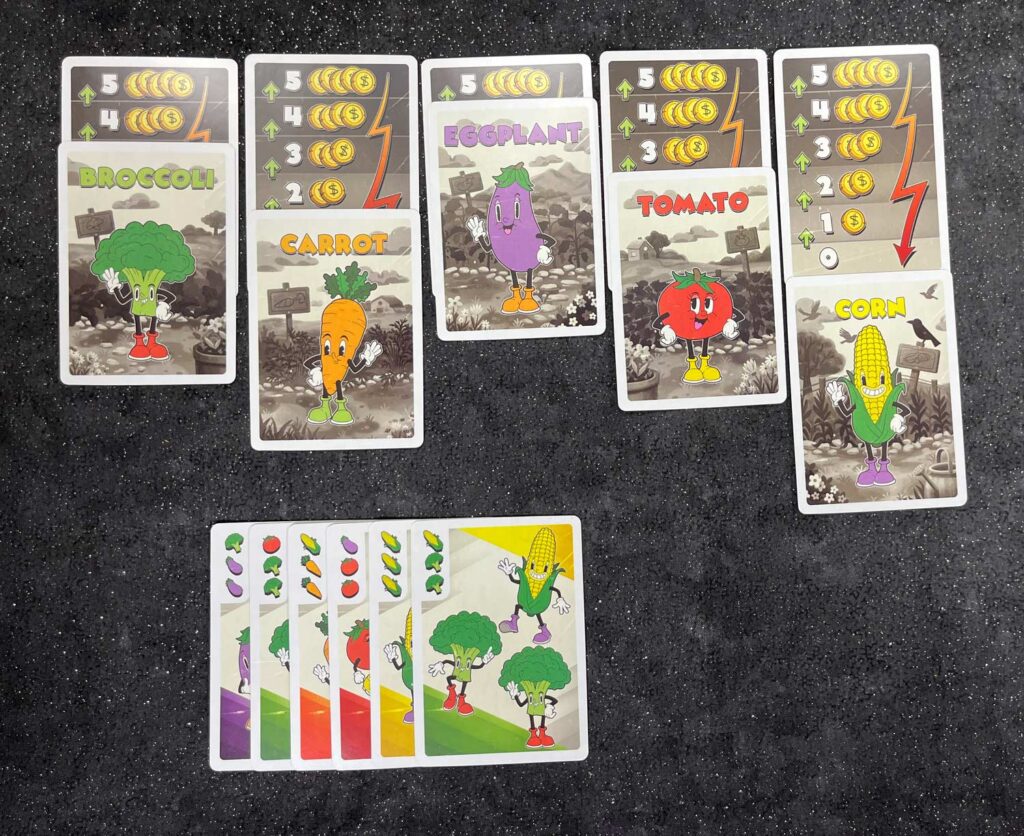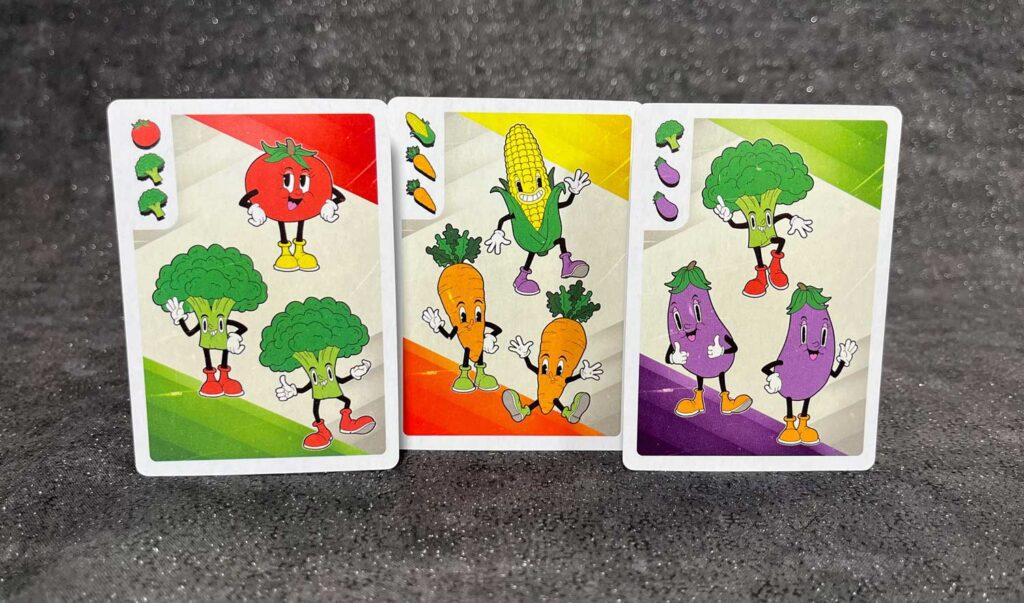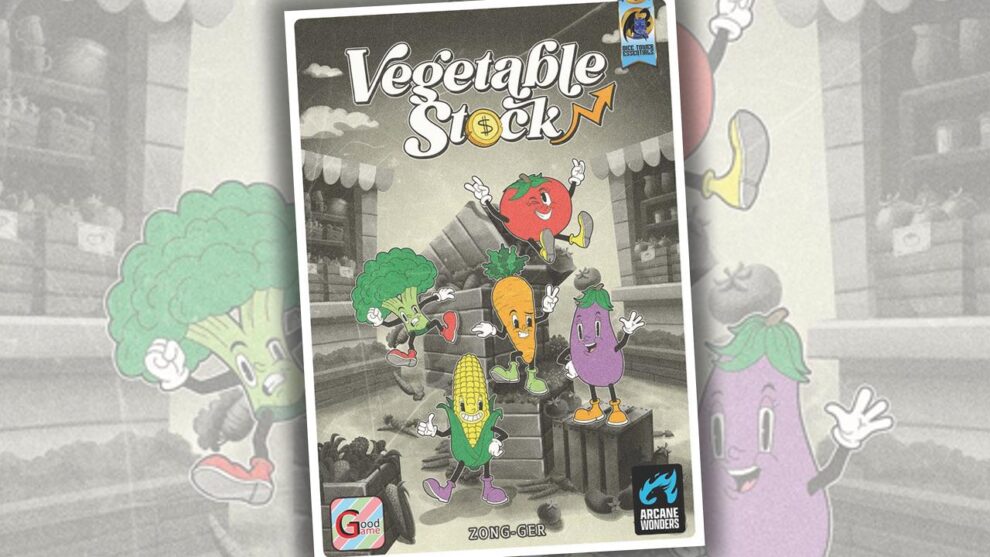Disclosure: Meeple Mountain received a free copy of this product in exchange for an honest, unbiased review. This review is not intended to be an endorsement.
In the fall of 2023 I stumbled across a lightweight card game called Vegetable Stock, originally from the publisher Taiwan Boardgame Design. This is a “market manipulation” game in which players choose cards for their personal “portfolio” and leave cards which may affect the value of said portfolios. Since my love of light card games is well known, but my love of clever puns less so, I immediately ordered a copy and had it shipped from Taiwan. It turns out the game is a delight, and fits perfectly into that light filler game category that I so adore. Now imagine my delight when Arcane Wonders licensed Vegetable Stock for release in North America and handed me a review copy at last year’s Essen SPIEL.
Vegetable Stock is soup-er!

How’d They Get All that Flavor into Vegetable Stock?
A quick note on setup: shuffle the 45 vegetable cards and place the deck in the middle of the table, dealing 1 card per player face up, with 1 additional card. So in a 4 player game you’d deal 5 cards face up. Take the 5 price cards and lay them out, then shuffle the 5 market cards and place them on top of the price cards in descending order: the first card should reveal the 5 coins, the second card should reveal the 4 coins etc. Once you’re set up, the game is ready to start. Note that in a 2 or 3 player game you remove all of the cards which have one vegetable (all carrots for example).

In Vegetable Stock players select vegetable cards from a center tableau and place their chosen card into their portfolio. No matter the player count, there is always one card leftover, and that card affects the current value of the market. For each veggie icon on the card, increase that veggie’s price card by one. If the value ever goes over 5, then that veggie’s market “crashes” and drops all the way to zero.
Play a total of 6 rounds, even if there are cards remaining. Then each player determines the value of their portfolio by multiplying the number of veggies they have against the final prices of the veggies. The winner is the player with the most points.
Dynamic Market & Weather Cards Variants
In addition to the base game, Vegetable Stock includes two simple variants.

Dynamic Market Variant
Each of the price cards have an alternate side in which the market adjusts by more than one at a time, and some prices are missing. This makes the market a bit less predictable. Furthermore, some players on BoardGameGeek have suggested a mix of regular and dynamic pricing cards, assigned randomly, so as to provide the utmost variety.
Weather Cards
Included in the box are two “weather cards”; a sun (good weather) and a typhoon (bad weather). The sun card causes an additional card to be dealt at the beginning of the round, which results in two cards at the end of the round—with both causing market increases. The bad weather card prevents market crashes on the round in which it is drawn from the deck. If a card would crash that round, it remains on 5.
Final Thoughts on Vegetable Stock
I won’t lie, my first thought upon seeing the original version of Vegetable Stock was that it was an outright ripoff of Point Salad, another excellent veggie-themed card game. The icons and vibrant colors were a bit too similar for my taste. Thankfully, artwork aside, the games are almost completely different from each other. And the new version from Arcane Wonders takes a hard right in graphic design, using a vintage art style reminiscent of early Mickey Mouse cartoons or Cuphead.


Every group I’ve played Vegetable Stock with has loved it. The game teaches in just a minute or two, and since it only takes about 10 minutes to play, any market crashes can be laughed off as chance.
The age on the box is listed as 6+ which I think is solid, but could even go lower, since all you really need to know is how to count up to about 8 or 9. The multiplication might get tricky for younger kids, but that’s what parents are for right? And, in fact, I think this would be an excellent game for kids. It teaches color and pattern recognition, counting, and making informed choices; but I digress…
You’re only getting to choose 6 cards. So early on it’s best to either focus on a single veggie and do your best to make sure that it either maintains its high value or steadily increases, or spread the love across every vegetable and hedge your bets. As the game progresses you can start to see what other people are collecting, and if they’re different from you. If so, you can attempt to select cards that prevent them from earning income or actively sabotage their portfolio by intentionally leaving cards which cause market crashes for those veggies. Because all the veggies are mixed together, it can be hard to make this happen without also affecting your own portfolio. But if you’re lucky enough to get one or more of the lucrative “3 veggie” cards then you might have a better chance.
If you enjoy light card games like I do, then Vegetable Stock is a great choice for your collection. It’s a single deck of cards, with no additional components. And just like a good stock is the basis for many soups, Vegetable Stock would be a great foundation to any game night.











Add Comment